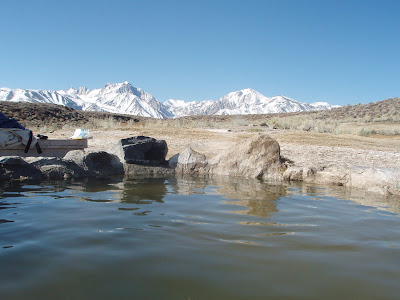
Bishop (formerly, Bishop Creek) is a city in Inyo County. Though Bishop is the largest city in Inyo County, the county seat is in Independence. It is located near the northern end of the Owens Valley, at an elevation of 4147 feet (1264 m). The population was 3,575 at the 2000 census. The town was named after Bishop Creek, flowing out of the Sierra Nevada: the creek was named after Samuel Addison Bishop, a settler in the Owens Valley.
The local hot water comes from the Long Valley Caldera, which hosts an active hydrothermal system that includes hot springs, fumaroles (steam vents), and mineral deposits. Hot springs exist primarily in the eastern half of the caldera where land-surface elevations are relatively low; fumaroles exist primarily in the western half where elevations are higher. Mineral deposits from thermal activity are found on an uplifted area called the resurgent dome, at Little Hot Creek springs, Hot Creek Gorge, and other locations in the south and east moats of the caldera.

The Long Valley Caldera is a depression in eastern California that is adjacent to Mammoth Mountain. The valley is one of the largest calderas on earth, measuring about 20 miles (32 km) long (east-west) and 11 miles (18 km) wide (north-south). The elevation of the floor of the caldera is 6,500 feet (2,000 m) in the east and 8,500 feet (2,600 m) in the west. The elevation of the caldera walls reach 9,800-11,500 feet (3,000-3,500 m) except in the east where the wall rises only 500 feet (150 m) to an elevation of 7,550 feet (2,300 m).
The primary thermal area in the Caldera is known as Hot Creek, which has cut into the floor of the caldera and passes through hot springs. The warm water of Hot Creek supports many trout, and is used at the Hot Creek Fish Hatchery. Hot Creek is part of a stream that follows part of a fault line and is well-known for its hydrothermal pools and for the contrast swimmers experience between the cold stream water and either the occasional plume of very hot water (which can scald swimmers' feet and can on rare occasions cause more serious injury) or even long and very strong upwellings of hot water when enough water is in the hydrothermal system. This area has been closed for several years due to increased thermal activity, i.e. people not exercising good sense getting themselves burned in the hot water.

Our first stop is called The Hot Tub. It is a beautiful stone hot tub fed by natural hot springs, located in the Inyo National Forest.

The view from The Hot Tub is really something.

Hot water is carried through PVC piping, from its source to a lovely stone soaking tub. The 5’ x 10’ x 2-foot deep pool is large enough for several friends to share together. The water measured 105º during our visit on a windy day. There is a small area next to the tub that has was smoothed with cement, who ever built this tub even set a tile chess board into the cement as it hardened, although no longer intact. The Hot Tub is a great place to relax and enjoy the scenery.

Next stop is The Crab Cooker. A near boiling source of hot mineral water is used to feed this rock and cement soaking pool, near the edge of Little Alkali Lake. Natural hot water is visible at its source about 50 yards from the tub. A concrete enclosure keeps kids and cows from scalding themselves, from here the water is piped underground to the hot tub. The tub itself measures 8’ x 14’ x 2-feet deep, with stone benches on two ends. The inlet pipe has a valve so bathers can turn it off when the tub is hot enough. It’s always a good idea to turn it off when you leave, otherwise the pool will reach 120º or more, making it hard to reach into the water to adjust the valves. There is also a drain at the opposite end, so bathers can pull the plug and easily clean the pool. Be sure to leave it empty to deter the cows!

As you can tell the tub was in need of a cleaning, which is precisely what I did.

As The Crab Cooker refills, it sure looks much more inviting, but the water temp is over 120, not exactly good for soaking. There is no source of cool water, so you fill it up, then wait for it to cool down. Next stop is Little Hot Creek. Hot springs flow into a hot creek where the water is piped into a concrete soaking tub, probably the least known soaking spot in this area, and the only one fenced off from local cows.

A wide flow of hot water streams with orange algae, as it flows down a gentle grade into pastures. The water is piped through PVC into a concrete soaking tub measuring about 10’ x 14’ and 2-3-feet deep, with tiered benches around the sides. The ingenious folks who made this tub even pressed beer cans into the drying cement to serve as cup holders while you soak. The inflow pipe brings water ranging from 106º – 115º into the tub, and is controllable by closing off the inflow so the water can cool to a comfortable temperature. There is also a drainpipe in the bottom of the tub, so bathers can easily clean it out.

These springs were in need of a cleaning too, so after a good soak, we drained the water and scrubbed it down. While we were here, some folks dropped by who had just visited The Crab Cooker and reported that it was still too hot for soaking.

Our soaking done, we pack up and head back to San Diego to get Matthew back before he is AWOL.


No comments:
Post a Comment